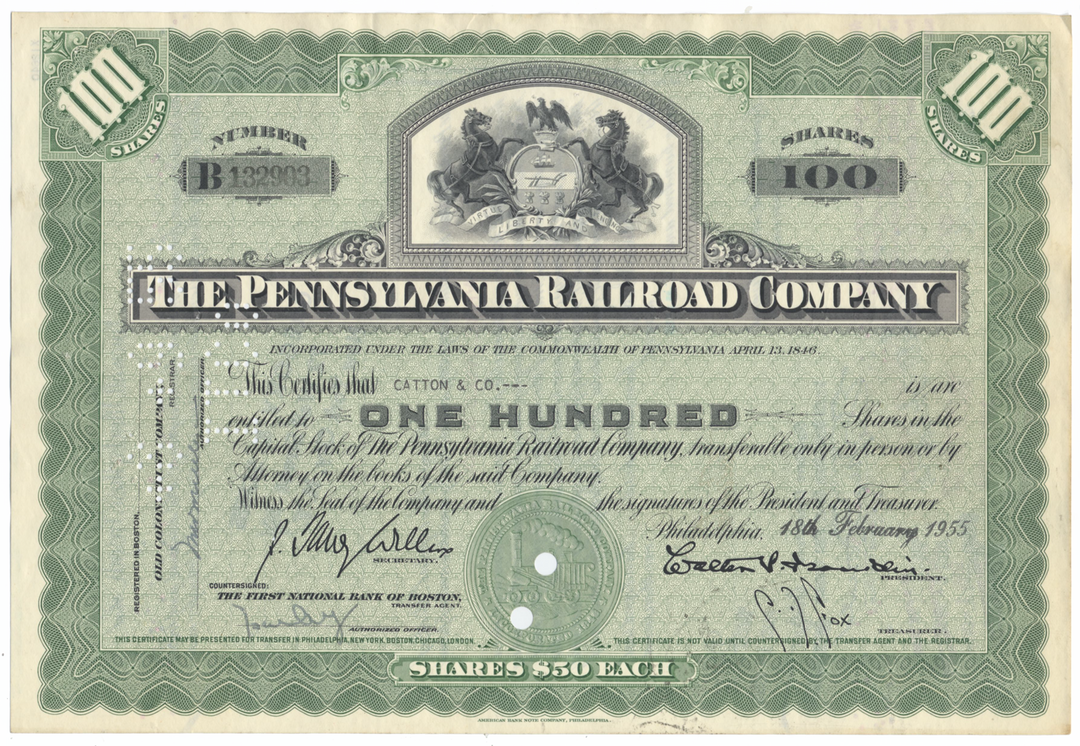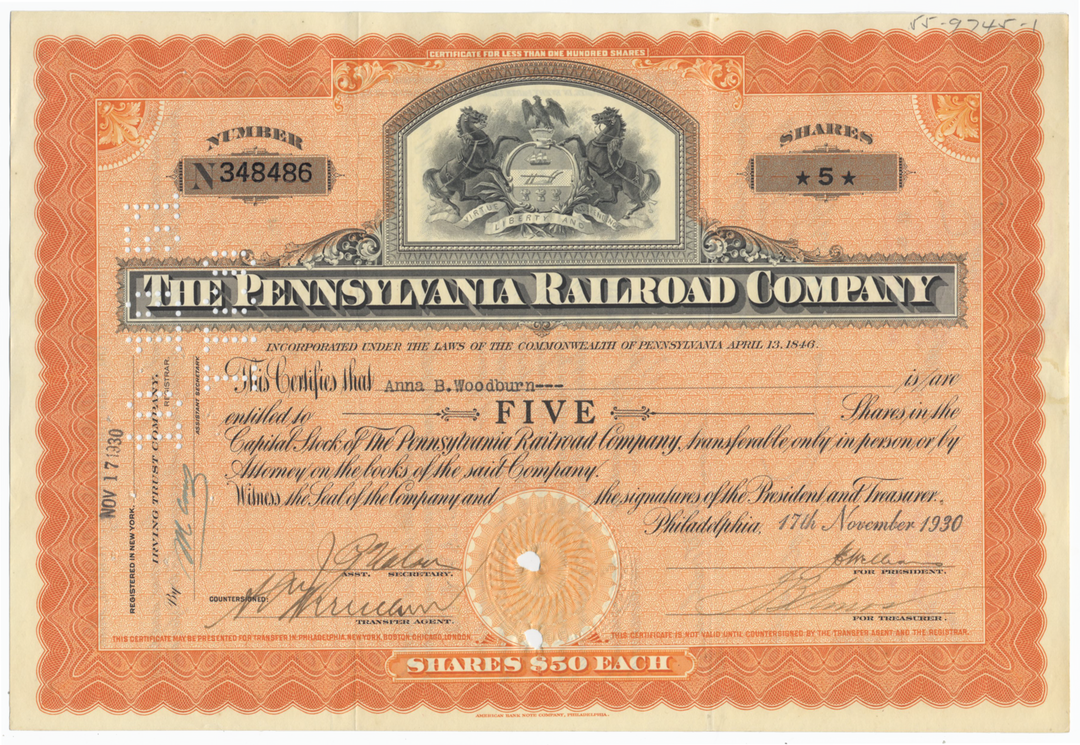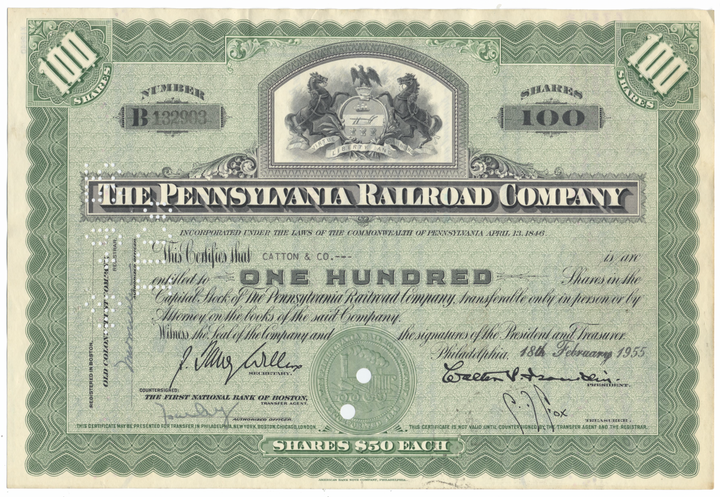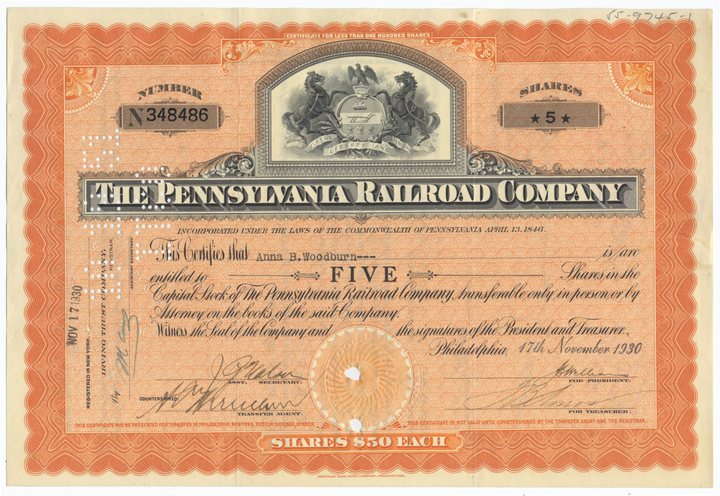Pennsylvania Railroad Company
- Guaranteed authentic document
- Orders over $75 ship FREE to U. S. addresses
Product Details
Company
Pennsylvania Railroad Company
Certificate Type
Capital Stock
Date Issued
1940's and 1950's
Canceled
Yes
Printer
American Bank Note Company
Signatures
Machine printed
Approximate Size
11 3/4" (w) by 7 3/4" (h)
Images
Representative of the piece you will receive
Guaranteed Authentic
Yes
Additional Details
NA
Historical Context

The Pennsylvania Railroad was founded in 1846 and merged in 1968 into Penn Central Transportation. Commonly referred to as the Pennsy, the company was headquartered in Philadelphia, Pennsylvania. The company's symbol was a keystone (Pennsylvania's symbol) with the letters PRR intertwined inside it. When colored, it was bright red with silver-grey edges and lettering (although it also appears in metal leaf outline on a wooden background on station benches).
The PRR was the largest railroad by traffic and revenue in the US throughout its 20th century existence and for a long while was the largest publicly traded corporation in the world. The corporation still holds the record for the longest continual dividend history: it doled out annual payments to shareholders for more than 100 years in a row.
Like the Reading Railroad, the PRR served Atlantic City, New Jersey; one of the four railroad squares in the board game Monopoly is called Pennsylvania Railroad.
The Standard Railroad of the World
For a long time the PRR called itself the Standard Railroad of the World, meaning that it was perceived as the standard to which all other railroads aspired, the "gold standard". For a long time that was literally true; the railroad had an impressive lists of “firsts,” “greatests,” “biggests,” and “longests.” The PRR was the first railroad to completely replace wooden-bodied passenger cars in favor of steel-bodied cars with greater strength and safety for equivalent weight. It led the way in many such safety and efficiency improvements over the years. These advantages lessened as the years progressed, and the PRR eventually abandoned the use of the slogan.
The Pennsylvania Railroad was standard in another way, too - it was an early proponent of standardization. While other railroads used whatever was at hand or available, the Pennsylvania tested and experimented with solutions until they could decide on one, and then made it standard across the whole company. Other railroads bought locomotives and railroad cars in small lots, taking whatever was available from manufacturers at the time. The PRR produced huge numbers of standardized designs. This gave the railroad a feel of uniformity and greatly reduced costs. The PRR was also an early adopter of standard liveries and color.
The Main Line
The PRR was chartered in 1846 to connect Harrisburg to Pittsburgh, and was completed in 1854. The part east of Harrisburg had been built earlier by the Harrisburg, Portsmouth, Mount Joy and Lancaster Rail-Road to Lancaster and by the Commonwealth of Pennsylvania as part of the Main Line of Public Works to Philadelphia.
Access to New York, Washington and Baltimore
In the early 1860s the PRR gained control of the Northern Central Railway, giving it access to Baltimore along the Susquehanna River (via connections at Columbia or Harrisburg).
On December 1, 1871, the PRR leased the United New Jersey Railroad and Canal Companies, which included the original Camden and Amboy Railroad from Camden, across the Delaware River from Philadelphia, to South Amboy, across Raritan Bay from New York City, as well as a newer line from Philadelphia to Jersey City, much closer to New York, via Trenton. Track connection in Philadelphia was made via the United Companies' Connecting Railway and the jointly-owned Junction Railroad.
The PRR's Baltimore and Potomac Rail Road opened on July 2, 1872 between Baltimore and Washington, but with a required transfer via horse car in Baltimore to the other lines heading north from the city. On June 29, 1873, the Baltimore and Potomac Tunnel through Baltimore was completed, and the PRR initiated the misleadingly-named Pennsylvania Air Line service via the Northern Central Railway and Columbia. This service was 54.5 miles longer than the old route via the Washington Branch of the Baltimore and Ohio Railroad and Philadelphia, Wilmington and Baltimore Railroad, but avoided a transfer in Baltimore. The Union Railroad opened on July 24, 1873, eliminating the transfer, and the PRR contracted with the Union Railroad and the PW&B. New York-Washington trains began using that route the next day, ending Pennsylvania Air Line service. The PRR acquired a majority of PW&B stock in the early 1880s, forcing the Baltimore and Ohio Railroad to build the Baltimore and Philadelphia Railroad to keep its Philadelphia access.
Low-Grade Lines
Around 1900, the PRR built several low-grade lines for freight to bypass areas of steep grades. These included the following:
1892 - Trenton Branch and Trenton Cut-Off Railroad from Glen Loch east to Morrisville (not only a low-grade line but a long-distance bypass of Philadelphia)
1892 - Waverly and Passaic Railroad (finished by the New York Bay Railroad) from Waverly, New Jersey to Kearny
1904 - reopening of the New Portage Railroad from the Gallitzin Tunnels east to New Portage Junction, then continuing north over the Hollidaysburg Branch to Altoona
1906 - Philadelphia and Thorndale Branch from Thorndale east to Glen Loch (abandoned by Conrail in 1989)
1906 - Atglen and Susquehanna Branch from Harrisburg via the Northern Central Railway south to Wago Junction, then east to Parkesburg (abandoned by Conrail in 1990)
The Pennsylvania and Newark Railroad was incorporated in 1905 to build a low-grade line from Morrisville, Pennsylvania to Colonia, New Jersey. It was never completed, but some work was done in the Trenton area, including bridge piers in the Delaware River. North of Colonia, the alignment was going to be separate, but instead two extra tracks were added to the existing line. Work was suspended in 1916.
Penn Central Merger
On February 1, 1968, the PRR merged with arch-rival New York Central to form the Penn Central. The ICC required that ailing New York, New Haven & Hartford Railroad be added in 1969. Penn Central declared bankruptcy in June 1970.
Successors
Penn Central rail lines were split between Amtrak (Northeast Corridor and Keystone Corridor) and Conrail in the 1970s. After the breakup of Conrail in 1999, the portion which had formerly been PRR territory largely became part of the Norfolk Southern Railway.
Timeline
1915 -PRR electrifies its Philadelphia-Chicago mainline between Central Philadelphia and Paoli.
1916 - PRR adopts new motto, "Standard Railroad of the World".
1916 - First I1s 2-10-0 "Decapod" locomotive completed.
1916 - A5s 0-4-0 and B6sb switching locomotives introduced.
1918 - PRR stock bottoms at $40¼ due largely to Federal railroad control, lowest since 1877.
1918 - Emergency freight routed through New York Penn Station and the Hudson tunnels at night by the USRA to relieve congestion.
1918 - N1s 2-10-2 locomotives introduced for Lines West.
1918 - PRR electrifies Chestnut Hill Commuter Line between Central Philadelphia and Chestnut Hill.
1928-1938 - PRR electrified its New York-Washington Mainline, the Chicago-Philadelphia Mainline between Harrisburg and Paoli, several Philadelphia and New York area commuter lines, and major through-freight lines.
1968 - Pennsylvania Railroad absorbs New York Central to form the Penn Central.
1999 - The United States Postal Service issues 33-cent All Aboard! 20th Century American Trains commemorative stamps featuring five celebrated American passenger trains from the 1930s and 1940s. One of the five stamps features an image of a GG-1 locomotive pulling the Congressional (A joint New Haven Railroad-PRR run-trough train) along Pennsy's route between New York and Washington, D.C., and whose slogan was "Every Mile Electrified!"
Equipment Colors & Painting
PRR colors and paint schemes were very standardized. Locomotives were painted in a shade of green so dark as to be almost black, called DGLE (Dark Green Locomotive Enamel) but often called Brunswick Green. Underparts were painted true black. Passenger cars were painted Tuscan Red, a brick-red shade. Lettering and lining was originally real gold leaf on passenger locomotives and cars, but in the post World War II period became Buff, a light yellow shade of paint. Some electric locomotives and most passenger-hauling diesel locomotives were painted in Tuscan also. Freight cars were painted Freight Car Color, an iron-oxide red.
Signaling
Trackside, the PRR was virtually alone in its exclusive use of position-light signals. The signals were designed by the Pennsy to replace semaphore signals, with an eye toward visibility in foggy conditions. Position-light signals used a large round target with an array of up to nine lights; eight are arranged in a circle near the edge of the target, with one more light in the center. Signal aspects were shown as rows of three lit lights that corresponded with upper-quadrant semaphore signal positions: vertical for proceed, a 45° angle for approach, and horizontal for stop. Additionally, a row of light at a 45° angle leaning left of vertical (perpendicular to the approach aspect) was also used for a restricting aspect, an "X" shape was a "take siding" aspect, and a full circle was a "raise pantograph" aspect in electrified territory. Additional aspects were conveyed with a second target head below the first, either a single light, a partial target, or a full target depending on the location.
The lights in position-light signals used amber colored lenses, which could penetrate fog more easily. The design also allowed train personnel to recognize the signal aspect even when one light in a row was inoperative.
In later years, the two outside lights in the horizontal "stop" row were often replaced with red lenses, and the center lamp would be extinguished when the signal displayed a stop aspect.
Steam Locomotives
For most of its existence, the PRR was conservative in its motive power choices and pursued a path of standardization, both in locomotive types and their component parts. Almost alone among American railroads, the Pennsy designed most of its steam locomotive classes itself and built a fair proportion of them in its own Altoona Works. In fact, the PRR is believed to have been the 4th-most prolific U.S. builder of steam locomotives, after the three largest commercial builders.
Outside builders were, of course, used - the sheer number of locomotives the PRR ordered was far greater than its own works could produce. Unlike most roads who left the majority of the decision-making and design to the locomotive builder, giving only a broad specification, the PRR generally used a commercial builder as a subcontractor, building exact replicas of an existing PRR design.
When it needed to use a commercial locomotive builder, the Pennsy favored Philadelphia's Baldwin Locomotive Works. Baldwin was a big PRR customer, for one thing — receiving its raw materials and shipping out its finished products on the PRR. Moreover, the two companies were headquartered in the same city, and PRR and Baldwin management and engineers knew each other well. When both the PRR and Baldwin shops were at capacity, orders generally went to the Lima Locomotive Works in Lima, Ohio. Only at a last resort, it seems, would the PRR use Alco, the American Locomotive Company, based in Schenectady, New York - serviced by and favorite locomotive supplier to the Pennsy's arch-rival, the New York Central Railroad.
The PRR had a definite style that it favored in its locomotives. The square-shouldered Belpaire firebox was a PRR trademark that otherwise found little favor in the United States; almost every PRR locomotive had it. It traded more difficult construction for a greater heating surface and simpler firebox staying. The PRR used track pans extensively to pick up water on the move, so the tenders of their locomotives had a comparatively large proportion of coal (which could not be taken on board while running) compared to water capacity. The PRR was wary of gadgets and its locomotives were not generally festooned with devices; the PRR also favored a neat mounting of such devices when necessary, leaving the lines of the locomotive comparatively clean. Smokebox fronts bore a round locomotive numberboard (freight) or keystone numberboard (passenger) and were otherwise uncluttered except for a headlamp mounted at the top, with a steam-driven turbo-generator behind it. In later years the positions of the two were reversed, since the generator needs more maintenance than the lamp.
The PRR, until its final years, preferred a philosophy of smaller locomotives rather than buying the biggest.
Each class of steam locomotive was assigned a class designation. Early on, this was simply an alphabetical letter, but when these began to run out, the scheme was changed so that each wheel arrangement had its own letter, and different types of the same arrangement were defined by a subsequent number. Subtypes were in turn indicated by a lower-case letter; superheating was designated by an "s" until the mid 1920s, by which time all new locomotives were superheated. Thus, for example, a 'K4sa' class was a 4-6-2 "Pacific" type (K) and of the fourth class of Pacifics designed by the PRR. It was superheated (s) and was of the first variant type (a) after the original (unlettered).
Electrification
The first lines of the Pennsylvania Railroad selected for electrification were parts of the Long Island Railroad in 1905 and the West Jersey & Seashore Railroad from Camden to Atlantic City in 1906. These lines were planned for multiple-unit car operation, and the service on the Long Island has been extended to more than half the entire trackage. The system used was 600 volts D.C. supplied through a third rail. The same system was planned and adopted for the Hudson and East River tunnels and Pennsylvania Station. Today over a thousand multiple-unit cars are operated on the Long Island alone.
The service from Philadelphia to Trenton was started in 1930, and in January 1933 through main-line service between the principal cities was placed in operation. The first test run of an electric train between Philadelphia and Washington occurred on January 28, 1935. On the following February 1 the Congressional Limiteds in both directions were the first trains in regular electric operation between New York and Washington, being drawn by the first of the GG-1 type locomotives.
All regular passenger trains between these cities were electrified by March 15 , and shortly thereafter through trains to the west were electrically operated from New York to Paoli.
Major Passenger Stations
The PRR built several grand railroad passenger stations in major cities, either alone or in conjunction with other railroads. These architectural marvels served as the hubs for the PRR's extensive passenger service. Many of these stations are still in use today, served by Amtrak as well as regional passenger carriers.
Union Station, Washington, DC - Union Station served as a hub for PRR passenger services in the nation's capital, with connections to the Baltimore and Ohio Railroad, and Southern Railway. The Richmond, Fredericksburg and Potomac Railroad provided a link to Richmond, Virginia, about 100 miles to the south, where major north-south lines of the Atlantic Coast Line Railroad and Seaboard Air Line Railroad provided service to North Carolina, South Carolina, Georgia, and Florida.
Penn Station, New York, NY - The original Pennsylvania Station was modeled on the Roman Baths of Caracalla; it was notable for its enormous railshed and infamous demolition in the railroad's waning years. The station was built in 1910 to provide direct access to Manhattan from New Jersey without having to use a ferry, and was served by the PRR's own trains as well as those of the PRR's subsidiary the Long Island Rail Road. The demolition did not, however, extend to the platforms, the tracks, or even some of the staircases.
Penn Station, Newark, NJ - This recently refurbished Art Deco station was built in the 1930s as part of the Pennsy's Northeast Corridor infrastructure. It still stands, unlike the enormous train shed of the New York station.
30th Street Station, Philadelphia, PA - In classical grandeur, the 30th Street Station displays its majestic - and traditional - architectural style with its enormous waiting room and its vestibules. The station, in spite of its apparent architectural classicism, was constructed in the early 1930s, when modern and art deco styles were more popular.
Union Station, Chicago, IL - The Pennsylvania Railroad, along with the Milwaukee Road and the Burlington Route, built Chicago's Union Station, the only of Chicago's old stations to still exist as a train station (the rest of Chicago's operating passenger stations have been substantially remodeled). It was designed by Graham, Anderson, Probst & White in the Beaux-Arts style.
Related Collections
Additional Information
Certificates carry no value on any of today's financial indexes and no transfer of ownership is implied. All items offered are collectible in nature only. So, you can frame them, but you can't cash them in!
All of our pieces are original - we do not sell reproductions. If you ever find out that one of our pieces is not authentic, you may return it for a full refund of the purchase price and any associated shipping charges.









